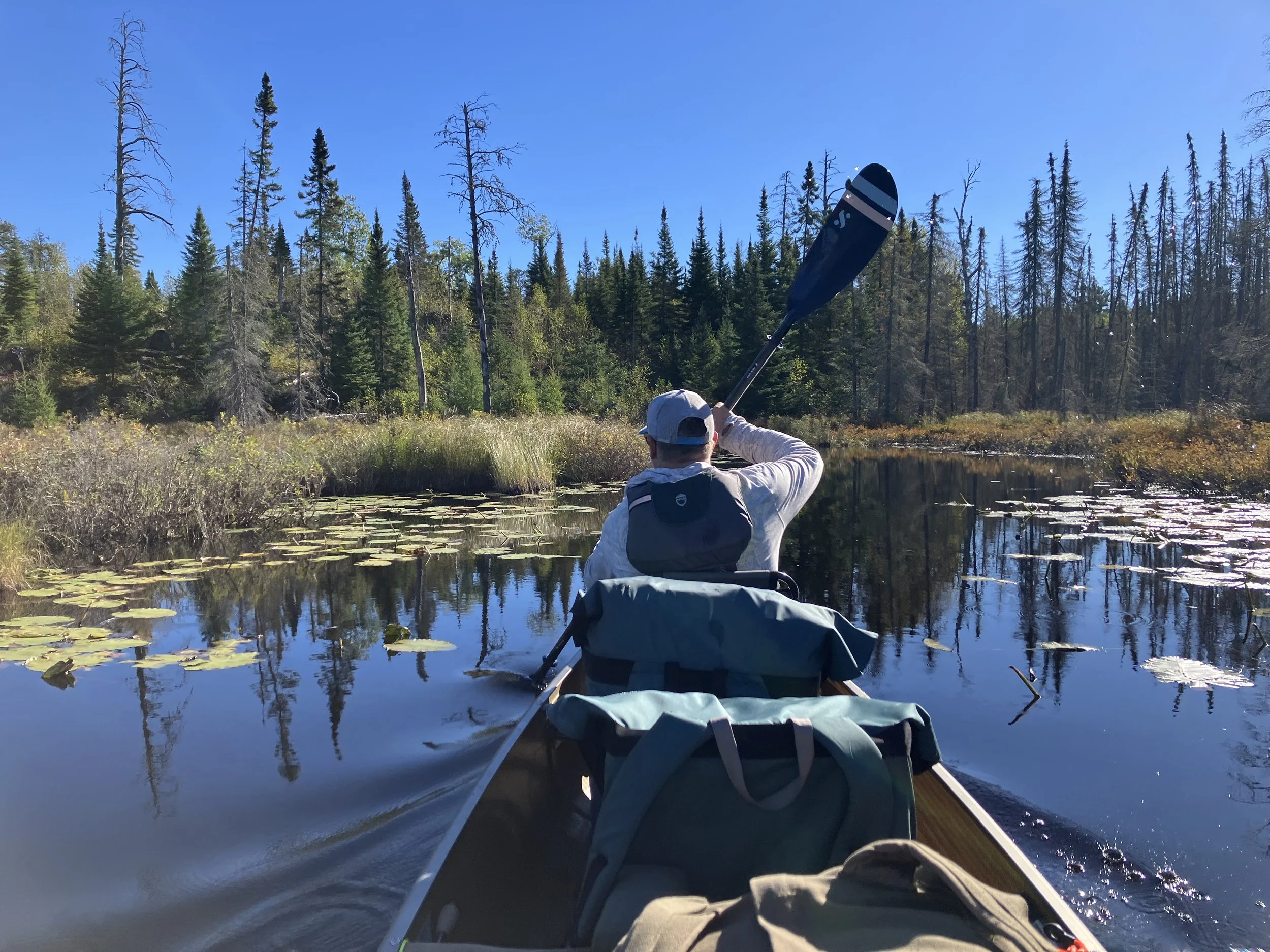Portage/Canoe Packs
While traditional backpacking packs can be used on canoe trips, purpose-built canoe portage packs are specifically designed for the unique demands of paddling and portaging. These packs are made to sit low and stable in the bottom of a canoe, helping maintain balance and maximize space. They feature heavier-duty construction and materials to withstand scraping on rocky shorelines—sacrificing some weight for durability since portaging is only part of the adventure. On the trail, their wide design and low profile distribute weight evenly across your back, allowing you to comfortably carry both your pack and a canoe on your shoulders during portages.
A useful packing approach for canoe camping is: one pack for gear, one for personal items (clothes, etc.), and one for food.
Dry packs also offer unique advantages as gear bags on canoe adventures. We share guide community feedback on the most preferred ones.
We are providing several options for gear and food packs in this section. Our insights come primarily from Boundary Waters Canoe Area (BWCA) outfitters and guides. With approximately 150,000 visitors each year, the BWCA serves as a proven testing ground for this specialized gear.
Outfitters in the region frequently support a small group of trusted manufacturers. The following guide-informed gear choices are organized by manufacturer. Reminder that we’re an affiliate link oriented company. We do receive, at no cost to our users, a small fee from the owners of the affiliate links we use. Please do use these links so that we can continue to offer and improve our Guide and Outfitter informed collection.
Granite Gear
Superior One
This is the largest pack in the group, boasting a generous 121-liter capacity (about 7,400 cubic inches). Built for durability, it features a thick, sturdy waist belt that distributes weight for more comfortable carrying.
Many paddlers like the idea of fitting everything into a single large pack, and there are clear advantages to that approach. However, in conversations with outfitters—who have outfitted thousands of clients and logged countless trips—a strong minority recommend more moderately sized packs instead. Their reasoning is simple: smaller packs help prevent overpacking, which can quickly turn your gear into what feels like a six-ton burden on the portage trail.
Quetico
The Quetico is the smallest of the three Granite Gear packs featured here and comes at a slightly higher price per volume than the others. While its product description emphasizes an advanced suspension system, most users we’ve spoken with feel that all three Granite Gear portage packs perform about the same on the trail.
Like its counterparts, the Quetico features high-quality stitching on the side handles for easy lifting in and out of a canoe and is built with the same durable materials throughout. With a capacity of 82 liters (about 5,000 cubic inches), it’s a reliable and well-constructed option for paddlers who prefer a more compact pack.
Traditional #4
The Traditional #4 is a moderately sized pack that balances capacity and manageability. While the Superior One may be better suited for longer trips or larger groups, the Traditional #4 delivers the same high-quality construction in a slimmer design.
Its 98-liter (6,000 cubic inch) capacity is still substantial—larger than the Quetico—without feeling overwhelming on portages.
Traditional Food Pack
The Traditional Food Pack is a mainstay in the stockrooms of many of our Outfitter partners. It features a straightforward, no-frills design that requires a cardboard liner (or similar insert) to provide side support.
By contrast, some of the higher-end food pack designs include closed-cell foam systems that give the pack and food compartment built-in structure. The Granite Gear Traditional Food Pack skips this feature, making it lighter and more affordable, but the tradeoff is clear—you’ll either use it as a structure-less bag or insert a cardboard box to keep the sides stable.
Portage North/Kondos
Portage North—formerly known as Kondos Outdoors—is based in Ely and manufactures all of its products locally. Many BWCA outfitters maintain personal relationships with the company and consistently praise both their craftsmanship and customer service. While their packs typically come at a higher price point than Granite Gear, outfitters in Ely are quick to assure you that the extra investment is well worth it for the quality you receive.
Outfitter 120
Comparable in size to Granite Gear’s Superior One, this pack can actually expand from 120L up to 170L with its top extension sleeve. That extra capacity is especially useful for large groups or for hauling lightweight, high-volume gear like sleeping bags. Its wide design also sits neatly in the bottom of a canoe, maximizing space. Built from top-quality materials and tested extensively in the BWCA, the pack benefits from Portage North’s close ties with local outfitters, ensuring a steady stream of product feedback and refinement.
The 90 is essentially a smaller version of the 120, featuring the same wide design and comfortable padded straps, just in a more compact package. Outfitters often note a key advantage of smaller packs: with a bigger pack, you’re more likely to overpack. This size strikes a smart balance, meeting the needs of most groups without tempting you to overload.
Outfitter 90
CoolerPak 74
Portage North also makes a soft-sided food bag similar to the Granite Gear Traditional Food Pack, but we heard enough positive reviews of this cooler-style food bag to include it here. It offers the same quality design and durable materials found across all Portage North products, with the added benefit of helping to keep food cool during the first stretch of a multi-day trip. The tradeoff is some extra weight compared to a standard soft-sided pack, but many find the added functionality worth it.
Cooke Custom Sewing
CCS is a premier manufacturer of high-quality canoe portage packs trusted by professional outfitters, seasoned guides, and wilderness enthusiasts across North America. Known for their exceptional durability, thoughtful design, and superior craftsmanship, these packs are consistently praised in online forums and gear reviews as the gold standard for backcountry travel and many outfitter employees attest to the fact that while all the packs they buy hold up well, it is the CCS packs that almost never need repair.
While they come at a premium price, users overwhelmingly agree the investment is well worth it. Proudly made in the USA, CCS combines rugged performance with American-made reliability—making them a top choice for those who demand the best in the field.
Hybrid Pack
The CCS Hybrid pack comes in three sizes (Explorer, Pioneer and Guide) and is available in a host of colors. The packs’ shoulder straps and padded waist belt are comfortable and help to distribute weight allowing for stability during portaging. As with other portage packs featured here, the low, wide profile allows them to fill out the base of a canoe while paddling and to permit clearance overhead for a canoe yoke and body necessary to carry your pack and canoe at the same time.
Explorer: 55L or 3350 cubic inches capacity
Pioneer: 77L or 4700 cubic inches capacity
Guide: 93L or 5700 cubic inches capacity
Deluxe Food Pack
CCS offers a solo food pack and an XL food pack, but this Deluxe Food Pack is the goldilocks of the bunch for most. It has the capacity for either larger groups or more moderately sized groups needing storage for a longer trip. The packs are comfortable to wear due to the suspension system and as the picture shows, they are constructed with a closed cell foam, helping the pack to hold its shape, which makes looking for that bag of granola down waaaay at the bottom much easier.
Dry Packs
Another canoe pack option that has grown in popularity in recent years is the dry pack. Long favored by whitewater paddlers and other adventure travelers, these waterproof bags are designed to keep gear completely dry—even if fully submerged. Constructed from heavy-duty vinyl or TPU-coated materials, they feature roll-top closures that create a reliable seal against water. While dry packs typically lack the structure and carrying comfort of traditional Cordura-style portage packs, they offer invaluable protection in heavy rain, on wet portages, or when stored in a canoe. Many trippers use them in tandem with standard portage packs—reserving dry packs for moisture-sensitive items like sleeping bags, clothing, and electronics, and using the larger, more ergonomic packs for bulk gear and food.
NRS Bill’s Bag Dry Bag
This bag from NRS is built to last, earning strong reviews for the durability of its PVC construction and reinforced bottom, which adds extra strength where it's needed most. It comes in a practical 65L size—perfect for a weekend trip and compact enough to fit in an airplane overhead bin—as well as a spacious 110L version for extended outings. While it's on the heavier side due to its rugged build, it excels in wet conditions; even when sitting in the bottom of a canoe collecting rainwater, your gear stays completely dry. NRS also offers a heavy-duty variant, featuring a thicker reinforced bottom that extends six inches up the sides for added protection.
Sealline PRO Dry Pack 120
The SealLine PRO comes in either a 70 or 120L volume and is a hefty pack. Our partners tell us that the padded shoulder straps, back padding and lumbar support make carrying this thing as comfortable as could be expected for a big bag. The 120L size is darn big, and can carry a load. A tough bag that can take a beating in and out of a canoe, scraping along rocky shorelines etc.














